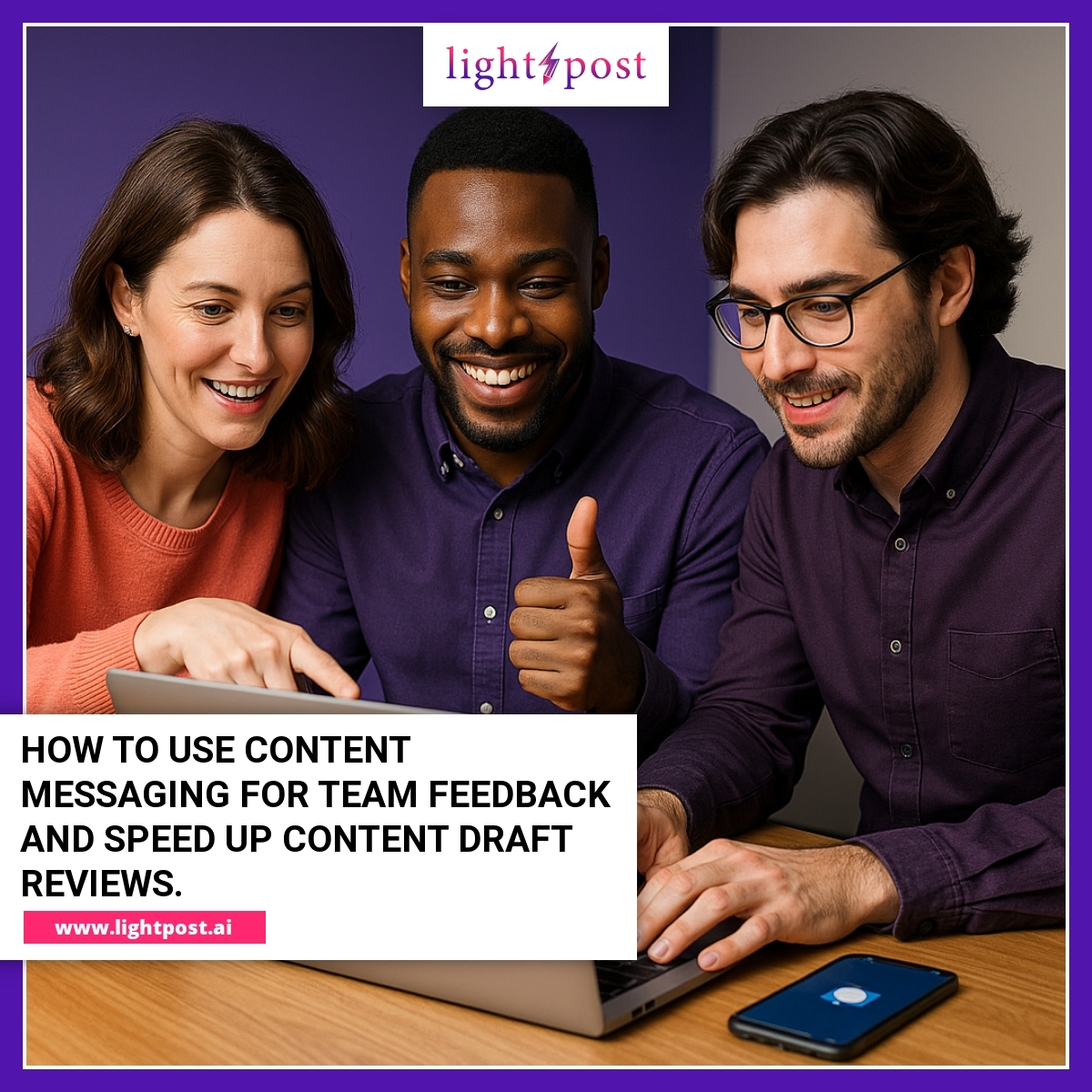Building Your First Quarterly Campaign Strategy Using Lightpost—Why Planning Content by the Season Drives Better Results
Think back to the last time you sat down to map out your content for the next three months. Most business owners either panic or shuffle through an old spreadsheet. There’s a hint of chaos that plays out in team Slack channels—deadlines get missed, posts come out days late, and social feels like a guessing game you can’t win. Now, what if there was a process that turned chaos into clarity, season after season, and kept every campaign laser-focused on what really matters?
Here’s the good news: the right approach does more than fill your calendar. It empowers teams to reach new audiences, leverage timely trends, and build momentum each quarter instead of starting from zero every month. So how do you make it happen—especially if you don’t have a huge staff or a stack of shiny tools? It starts with learning how to create a campaign strategy that actually plans for the rhythm of the year.
What’s a quarterly campaign strategy, and why’s it (actually) work better?
Quarterly campaign strategy is the process professionals use to break the year into three-month, highly focused sprints designed for goal tracking and responding to seasonality. People often ask how to create a campaign strategy that actually drives results; it comes down to structuring work around real calendar quarters—that's January to March, April to June, and so on—so your team can align marketing goals, batch resources, and self-correct at the perfect touchpoints.
For businesses using Lightpost, quarterly campaign strategy means more than just filling out a content calendar; it’s about using AI-driven insights, collaboration tools, and clear structure to turn scattered ideas into a unified plan that makes every social post and campaign asset count. Pros always align campaigns with seasonal market shifts—like holiday spikes or annual budget resets—while beginners without a plan run out of ideas or miss important deadlines entirely. By planning in quarters, you can batch content, see trends, and optimize your marketing for impact, not just activity.
The big pitfall: skipping those quarterly check-ins. Most teams just “keep going” and miss their targets. Mark out time after each quarter for honest analysis—ask what worked, what flopped, and what needs changing for next sprint. Have you ever set big goals for January, then realized in March you never circled back? That’s the fix.
So why does chunking content by quarters outpace the old-school monthly scramble? The answer ties directly into seasonal shifts, and it’s often missed by even experienced marketers. What crucial “seasonal” angle makes all the difference next?
OK, so what’s the “seasonal” twist that most people miss?
Strong campaign optimization relies on weaving in seasonal content planning, not just dumping topics into the calendar. The best teams mine analytics to find real-world trends—think holiday shopping, business budgeting cycles, or events in your niche—and sync these spikes with content. Analytics reveal that just after Christmas, the Q5 period delivers a hidden engagement surge as folks shift to new-year habits. Smart marketers build campaigns to ride those waves, not just to keep momentum steady. Strategy means color-coding your content calendar to anticipate, not panic-react, to gaps.
By regularly tracking internal analytics and mapping content to these annual markers, professionals see opportunities others miss—like higher conversion weeks or timeframes when certain posts naturally perform better. Overlooked? Most teams only realize they missed the boat after it’s sailed—another reason batching seasonal content pays off. As search engines now prioritize freshness, tuning campaigns to seasons maximizes reach and builds what Sam Altman called “the compound interest of marketing: small consistent campaigns timed right, growing over quarters.” Next up: how does Lightpost actually guide quarterly planning from the first step?
How do you even start planning your quarterly campaign strategy with Lightpost?
To kick off effective quarterly planning in Lightpost, start by building a reverse calendar: choose your quarter’s ultimate goal—maybe it’s new signups or a product launch—and work backward by marking every holiday, event, and must-hit milestone. This gives your team clear deadlines and prevents important campaigns from sneaking up at the last minute. By embedding everything into one workflow, nothing slips through.
Lightpost makes scheduling, drafting, and reviewing simple—its unified workspace lets you drag and drop campaign assets, assign teammates, and set reminders, so content always moves forward. Templates, custom-built for each campaign framework, let teams plug and play every month instead of starting from zero. The trick is spreading workloads across all three months; don’t dump everything into “the busy month,” or you’ll burn out before the quarter ends. Many teams fumble by loading April, then crash by May. Avoid it by scheduling wisely—Lightpost helps it happen with a few clicks.
Wondering how to spot workflow bottlenecks or keep your sanity as the calendar fills up? There’s a hack for that.
The hack: How campaign calendars save your sanity (no, really).
- Smart quarterly planning means plugging events, launches, and holidays into your calendar before layering in campaigns. Pinpoint real deadlines, then build your messaging with purpose—so you never scramble last minute. This keeps your team clear and calm.
- Integrate Lightpost with your Google Calendar for full-visibility. Assign each asset to a real date. Set up automatic alerts for approval windows and status changes—kill confusion over missing images or late posts.
- Use the content calendar to show the whole team what’s in play for each week. Transparency reduces bottlenecks and busts guesswork about “what goes live when.” Next, what’s the true secret for SEO success going quarterly?
What makes quarterly campaigns so effective for SEO in 2025?
Quarterly planning turbocharges content freshness, the top ranking factor for SEO 2025. This means each quarter, your team is prompted to create, schedule, and revisit posts—keeping your online presence active and competitive. Tools like Lightpost help teams batch keyword research and optimize anchor text, allowing seamless updates of evergreen and timely content.
The evidence is clear: by aligning campaigns to seasonal peaks and regularly cross-linking content, websites provide users (and Google) more relevant, continuous journeys. Structured plans ensure your brand hits all the right “freshness” windows, outpacing competitors who scramble to update after they see a drop in rankings. Quarterly strategy means more evergreen refreshes and strategic keyword updates—an ongoing cycle that wins in search. Teams stumble when they ignore internal links between posts; quarterly mapping fixes this, prompting regular connection between themes.
So, what’s the actionable way top teams connect campaign strategy to SEO for real, measurable lift?
Here’s how pros connect quarterly campaigns to SEO (and what beginners forget).
- Stack quarterly content around campaign themes using keyword clustering—plan evergreen, seasonal, and surge topics in advance so each update builds relevance over time.
- Never set and forget your content. Pros actively revisit each post during the quarter to adjust titles, update keywords, and repurpose for trending topics—keeping content optimization sharp.
- Link relevant assets with internal links to maximize SEO cycles and hand off authority throughout your site. Next, discover which tools make it all achievable without endless hours lost.
Lightpost automates nearly every tedious step—reminders, draft approvals, content scheduling, and publishing—so teams focus less on busywork and more on creative ideas. The platform’s built-in AI Writer drafts campaign outlines, posts, or entire guides for you, making it quick to brainstorm new concepts or create seasonal content at scale. Save your edits and custom tweaks so nothing sounds generic.
By stacking ready-made templates for each quarter—think “Back to School,” “Holiday Promos,” or “Q1 Kickoff”—your crew skips repetitive builds, instead plugging in updated info and moving forward confidently. Yet, here’s what even savvy managers sometimes forget: always review automated content for tone and context. Let the system handle routine drafts, but manually check key messages so your campaigns always feel authentic.
Problems sometimes arise when feedback loops get skipped or bogged down in email threads. So what “workflow move” actually accelerates reviews and collaboration?
Never lose track: How approval and collaboration really speed things up here.
- Lightpost’s built-in collaboration lets every team member and stakeholder comment, suggest edits, and approve assets in real time—eliminating clunky email chains and lost feedback.
- Set up auto-notifications for any campaign item stuck more than 24 hours in review, so bottlenecks are flagged instantly and content never lingers past launch windows.
- Use shared asset folders and version tracking inside Lightpost to avoid duplicating work, so your team always knows what’s live, in review, or queued to post. Wondering how to turn all this planning into tangible results every quarter?
So how do you actually measure results and make next quarter smarter with Lightpost?
Set clear KPIs at the start of every quarter—whether it’s higher engagement, more site traffic, or increased conversions—and use Lightpost’s unified dashboard to keep everyone accountable. The best teams don’t leave measurement to chance; they pull campaign recaps every month, then run a deeper workshop after the quarter to map out hits, misses, and “unexpected wins.” Then, adjust the next campaign strategy on the spot.
A “pro move” is exporting campaign notes and wins to share with your team or clients, so everyone gets clarity on what actually works instead of just guessing. Tag content that underperforms—don’t hide flops. Review as a group, brainstorm improvements, and revisit your strategy in Lightpost so every quarter moves you a step further toward your business goals. Watch for teams who gloss over weak results or celebrate early; they’re missing the workshop moment that turns losses into future hits.
Not every campaign crushes it, but each one teaches something. Here’s how pros wring every drop of value from last quarter’s lessons.
The move: How to turn campaign flops into your biggest wins.
- Treat underperforming content as a hidden goldmine; rework it, reposition it in a new campaign, and track what improves. Many teams see lift after a simple timing tweak or headline refresh.
- Use Lightpost’s powerful archive to store all assets—search by theme or quarter so nothing useful gets lost, and every test becomes part of your long-term content bank.
- Repurpose winning content types across different platforms and quarters, especially around recurring events or holiday cycles. Over time, your template library turns one strong idea into multiple scalable efforts.
“Success is not final, failure is not fatal: it is the courage to continue that counts.” With every quarter, Lightpost helps you harness that courage through smarter systems and a relentless focus on optimization. As 2025’s marketing best practices prove, focused, seasonal, and collaborative quarterly planning doesn’t just reduce workload—it compounds your results, organizes your team, and makes every campaign count. Ready to see how it works?
If you’re ready to stop guessing and start building social campaigns that run like clockwork, try Lightpost. Join hundreds already using it to simplify their lives, stay on message, and drive business growth (🐣, 🎯, 💡). Sign up for a free demo now and watch your strategy scale.
[*SOURCES: northbeam.io, klaviyo.com, theclose.com]






